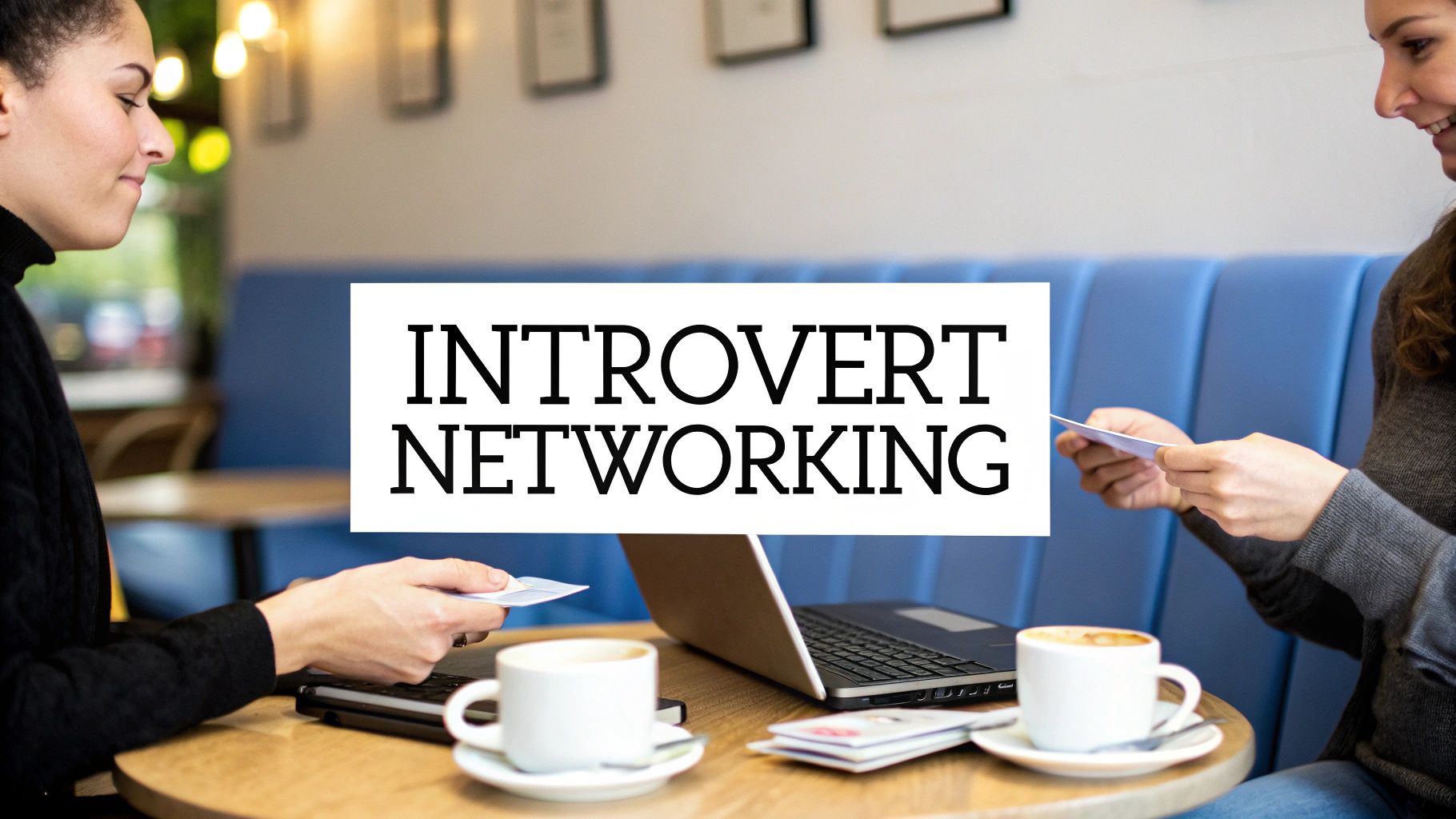
How to Network as an Introvert: Easy Tips for Genuine Connections
Published on 2025-07-12
The usual advice for introverts—"just put yourself out there!"—is not only unhelpful, it completely misses the point. The secret to successful networking isn't about fighting your nature; it’s about embracing it. Your greatest assets are the very things that make you an introvert: your ability to listen intently, to think deeply before you speak, and to forge genuine, one-on-one connections.
Your Introvert Strengths Are Your Superpower
Let's be honest. For many introverts, the word "networking" conjures images of a loud, crowded room where the goal is to collect as many business cards as possible. It sounds exhausting. But that whole picture is outdated. Real professional networking is about quality, not quantity.
Your way of connecting isn't wrong, it's just different. So, instead of trying to fake an extroverted personality, let's reframe the entire activity. Stop thinking of it as "working a room" and start seeing it as "building thoughtful relationships." Your natural inclinations are actually perfect for this.
Redefine Networking on Your Own Terms
You don't need a personality transplant to build a strong professional circle. The real magic happens when you lean into what you already do best.
So, what are these built-in advantages?
- You're an incredible listener. You naturally absorb what people are saying instead of just waiting for your turn to talk. This makes others feel genuinely seen and heard, which is the bedrock of any real connection.
- You're a thoughtful preparer. You like to process things internally before speaking. This means when you do join a conversation, you come in with purpose, ready to ask insightful questions that spark memorable discussions.
- You prioritize meaningful connections. You're wired for depth. This naturally leads you to build a smaller, more loyal network of true allies instead of a massive list of acquaintances.
The real goal of networking is to turn a stranger into a professional ally. Your introverted nature, which favors one-on-one interactions and deep conversation, is an asset in achieving this.
In a world full of noise, this is a huge advantage. And you're far from alone. Studies estimate that somewhere between 25% and 40% of the population identifies as introverted. That means in any given room, a good chunk of people probably feels the same way you do and would welcome a calmer, more focused way of connecting. If you're looking for more ideas, you can find some great networking skills examples on Playablo that align with these tendencies.
Let's look at how introverted and extroverted strengths play out differently—but equally effectively—in networking.
Introvert Strengths vs Extrovert Strengths in Networking
While both introverts and extroverts can be fantastic networkers, they often succeed by using different sets of skills. Understanding your unique advantages is the first step toward using them confidently.
| Networking Aspect | The Introvert Advantage | The Extrovert Advantage |
|---|---|---|
| Conversation Style | Deep, focused one-on-one discussions. Asks thoughtful questions. | Engaging with multiple people at once. Thinks well on their feet. |
| Relationship Building | Forms a few strong, lasting bonds built on mutual interest. | Creates a wide circle of contacts and acquaintances quickly. |
| Event Approach | Arrives prepared with specific goals and people to meet. | Thrives on spontaneous interactions and high-energy environments. |
| Listening Skills | Actively listens to understand, making others feel valued. | Gathers information from many sources in a short amount of time. |
| Follow-Up | Sends personalized, thoughtful follow-ups that reference the conversation. | Quickly follows up with a broad group to maintain momentum. |
Recognizing these differences shows that there isn't one "right" way to network. Your approach is just as valid and, in many cases, can lead to more durable professional relationships.
The data below further illustrates how common introverted traits are and why they naturally lead to more selective, but powerful, networking preferences.
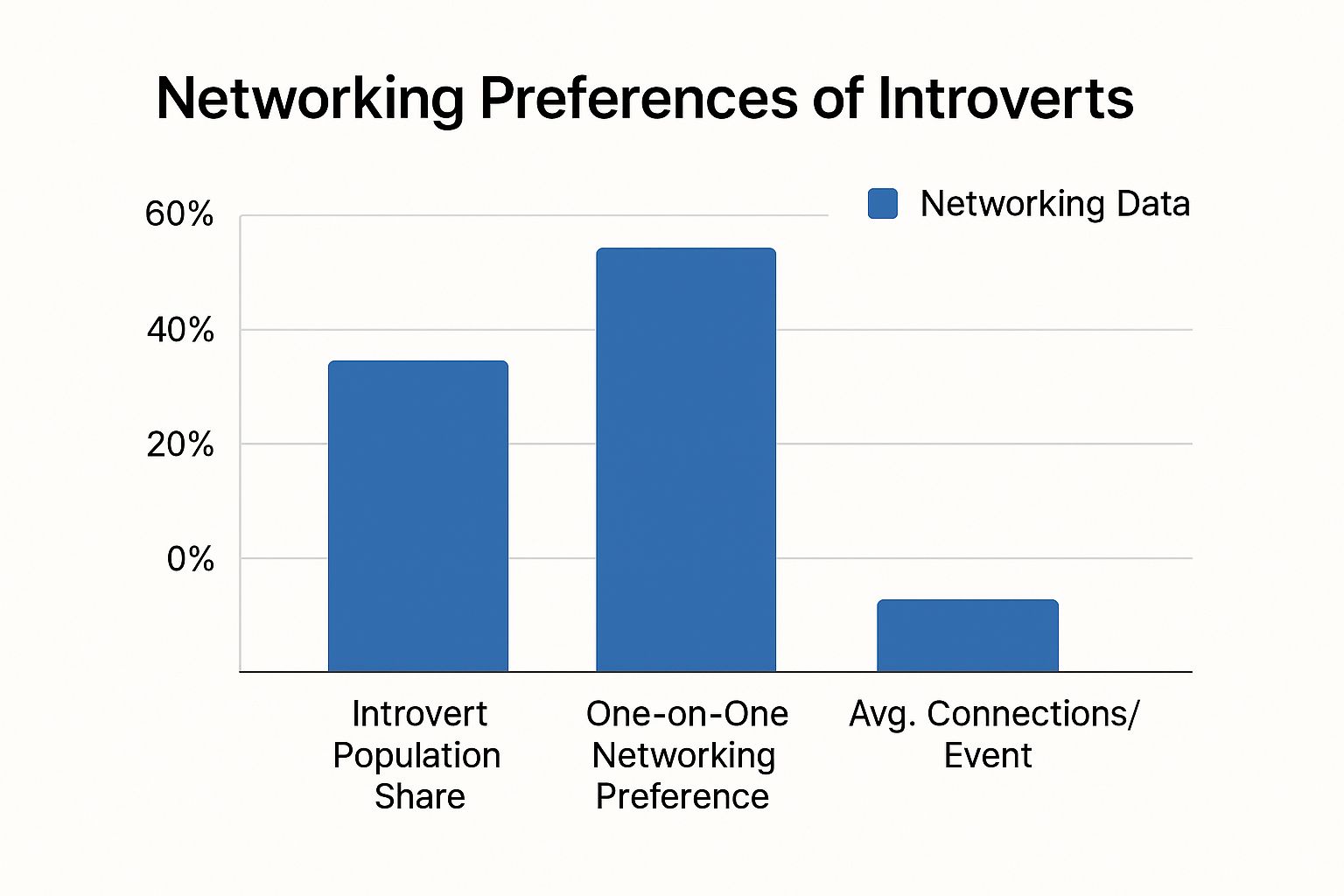
This really drives home the point: while introverts make up a huge portion of the population, our preference for quality interactions means we may leave an event with fewer contacts, but the ones we do make are far more likely to be meaningful.
Getting Ready for Networking Events
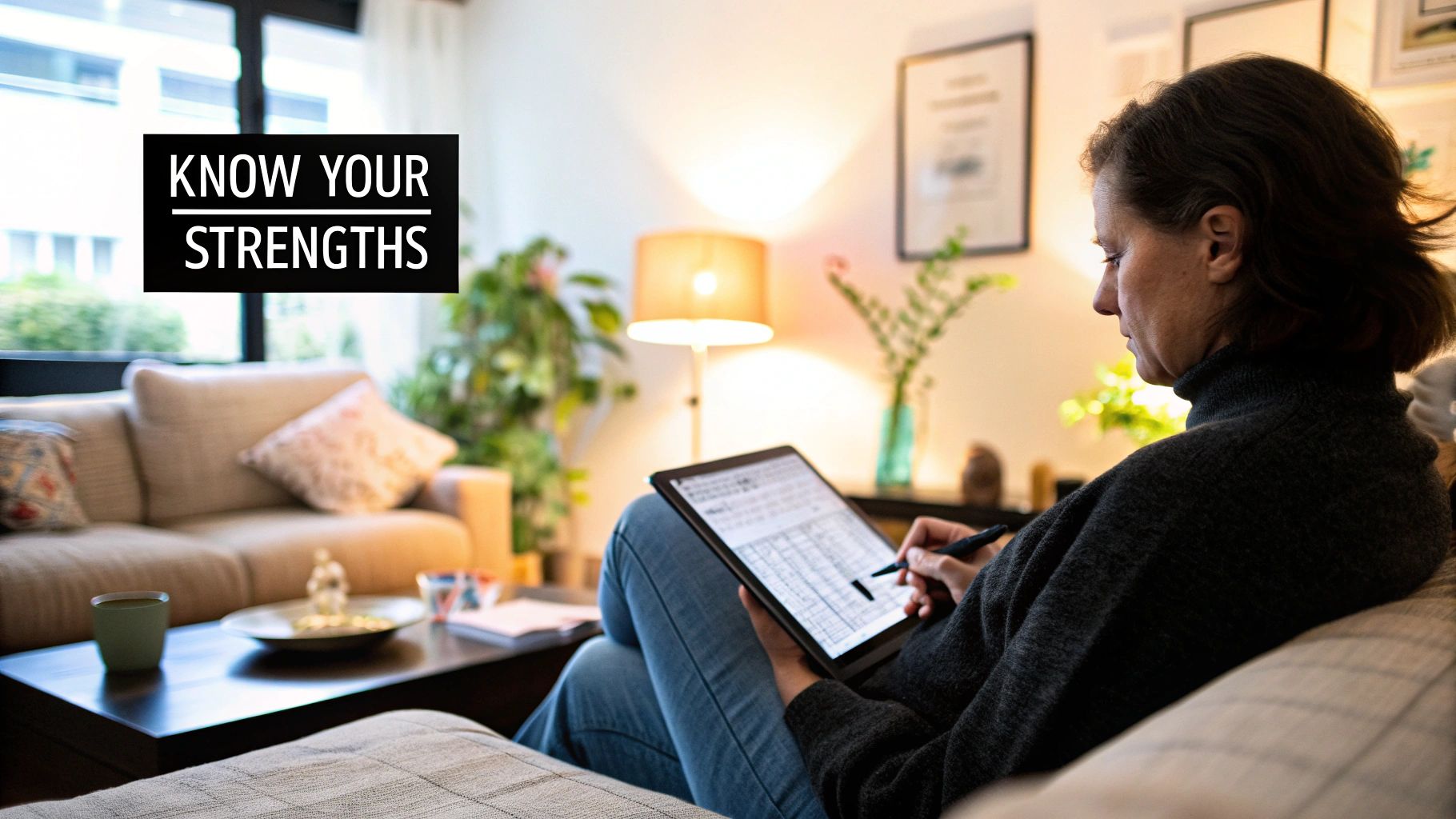
Let's be honest: for an introvert, the idea of walking into a room buzzing with strangers can be terrifying. But here's the secret I've learned over years of navigating these events: confidence isn't something you're born with, it's something you build through preparation.
A little planning before you walk out the door can completely change the game. It turns a huge, overwhelming social hurdle into a clear, manageable mission. This isn't about faking it or trying to be an extrovert. It’s about creating a strategy that lets you play to your strengths and make a few high-quality connections that actually mean something.
Figure Out Your "Why"
Before you go anywhere, ask yourself one simple but powerful question: "Why am I actually going to this thing?"
Your answer is your North Star. Maybe you're on the hunt for a collaborator for a new project. Perhaps you're hoping to soak up some knowledge from industry veterans. Or maybe you just want to get a sense of the professional community in your city. Pinpointing your "why" gives you a real sense of purpose and makes the whole event feel less like a chore.
With your purpose clear, you can set a small, achievable goal. This is where the magic happens for introverts, because it completely changes the definition of a "successful" night.
Forget trying to meet everyone. Your goal isn't to collect the most business cards. Instead, aim for something simple and concrete, like having two or three genuinely interesting conversations. This transforms a vague, high-pressure situation into a clear, low-stress task.
Social events can drain an introvert's battery fast. Setting a specific, small goal—like connecting with just a few people—helps you focus your energy where it matters most. It prevents burnout and allows you to do what introverts do best: build deeper, more authentic relationships. This goal-oriented approach for introverts is a proven strategy for making networking feel more natural.
Pack Your Conversation Toolkit
Now that you have a goal, it's time for a little light prep work. Think of it less like studying for an exam and more like gathering a few tools to make your job easier.
Do a Little Recon: If the event organizers have shared a guest list, take a quick peek. A brief scan of a few LinkedIn profiles might reveal a shared alma mater, a past employer, or a common interest. Just finding one or two people you genuinely want to talk to gives you an immediate mission when you walk in the door.
Arm Yourself with Easy Openers: One of the biggest hurdles is just starting the conversation. Having a few low-stakes questions in your back pocket removes that initial anxiety. They don't have to be clever, just effective.
A few of my personal go-to's are:
- "So, what brings you out to this event?"
- "I noticed you work at [Company Name], I've always been curious about what they do. How do you like it?"
- "This is my first time at one of these. Have you been before?"
These simple steps shift your mindset from a place of anxiety to one of action. You'll walk in the door not as a nervous introvert, but as a prepared professional ready to make a few great connections.
Let's be honest: the idea of a big, in-person event can send most introverts running for the hills. The wall of noise, the sea of unfamiliar faces, the constant pressure to "mingle"—it can be a lot. But you don't have to just grit your teeth and bear it. With the right game plan, you can walk into these events feeling prepared, make them work for you, and maybe even enjoy yourself. It’s all about being intentional and protecting your energy.
One of the best things you can do is simply show up early. I’m not talking an hour early, but just 10-15 minutes before things officially kick off. Walking into a room that’s already buzzing is jarring. But getting there before the crowd descends? That’s a game-changer. It gives you a moment to get your bearings, find the layout, grab a drink, and just breathe before the action starts. You go from feeling like you're crashing a party to feeling like a calm, early arrival.
Find Your Power Spot
Once you're there, where you stand can make all the difference. Instinct might tell you to find the quietest corner and merge with the wallpaper, but that’s counterproductive. Instead, look for a spot that’s high-traffic but low-pressure.
The area around the food and drink tables is perfect for this. People are constantly moving in and out, creating natural, fleeting opportunities for a quick chat. It’s so much easier to strike up a conversation when you have a shared, simple reason to be in the same spot. A simple, "Those mini-quiches look amazing, have you tried one?" can be the perfect, low-stakes opener that leads to a real conversation. You're letting people come to you.
The goal isn’t to command the room. It's to find a comfortable base where conversations can spark naturally, without you having to force anything.
The Art of the Graceful Exit
Knowing how to start a conversation is only half the battle; knowing how to end one politely is a superpower. Many introverts dread getting stuck in a conversation they don't know how to leave. The good news is, you don't need a complicated excuse. A simple, friendly closing line is all it takes.
Keep a few of these in your back pocket:
- "It was really great chatting with you about [topic]. I'm going to try and say hello to a few more people, but let's connect on LinkedIn."
- "Well, I'm going to grab a refill before the next speaker starts. It was a pleasure to meet you!"
- "I don't want to take up all your time, but thank you so much for the great conversation."
These are polite, clear, and end the interaction on a high note. After you’ve made a good connection, the follow-up is everything. To keep that momentum going, you’ll want to learn how to effectively grow your LinkedIn connections so those new contacts turn into lasting relationships.
Protect Your Social Battery
This might be the most important tip of all: take breaks. Your social energy isn't unlimited, so don't treat it like it is. When you feel that familiar sense of overwhelm creeping in, that's your cue to step away for a few minutes. It's not rude; it's strategic.
Duck outside for a breath of fresh air. Find a quiet hallway. Even a five-minute retreat to the restroom to scroll on your phone can do wonders. Think of it as a quick pit stop to refuel. These small moments of solitude will recharge your battery, helping you avoid that dreaded post-event "introvert hangover" and making the whole experience feel much more manageable.
Building Your Network from Behind the Screen
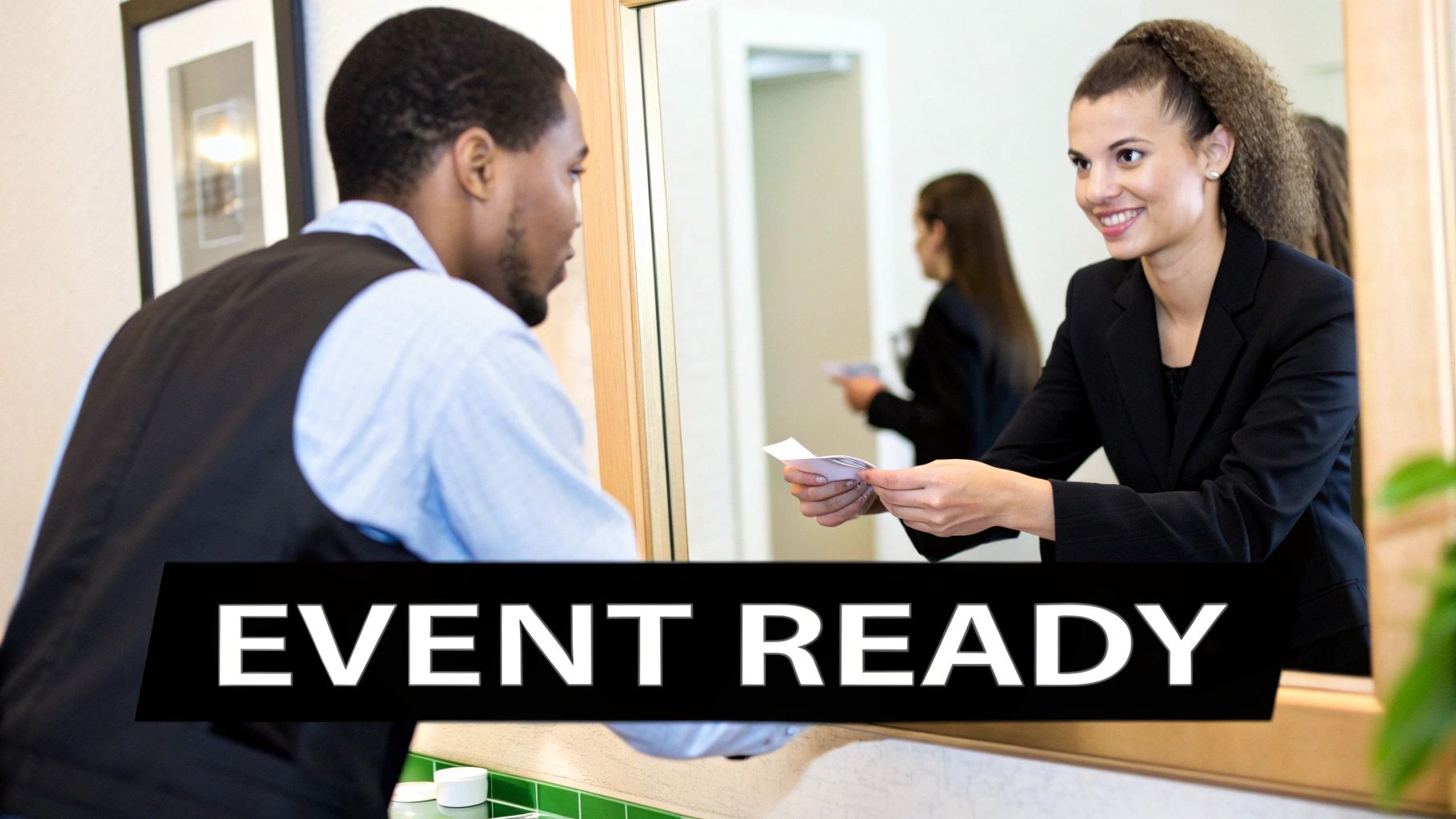
If the thought of another crowded conference room makes you want to hide, I’ve got good news. You can build an incredible professional network without ever leaving your house. For many of us introverts, networking online isn't just a pandemic-era substitute; it’s where we thrive.
Digital platforms let you play to your strengths. You can take your time, think through your words, and be far more strategic than you ever could be shouting over music at a mixer. It's about moving from a passive scroller to an active, thoughtful participant on platforms like LinkedIn or niche industry forums. The goal is the same as in-person networking: quality over quantity.
Craft Connection Requests That Actually Get a "Yes"
Let’s be honest, the generic “I'd like to connect with you on LinkedIn” message is the digital equivalent of a weak handshake. It's forgettable at best and lazy at worst. This is where your introverted nature gives you a secret advantage—you’re already wired to be more deliberate.
So, before you hit that connect button, take just 60 seconds to make it personal. Did you see them speak on a webinar? Do you admire a project they led? Do you have a shared connection? Mention it! A short, genuine note cuts through the noise.
"Hi Sarah, I really enjoyed the article you shared yesterday about sustainable UX design. Your point about accessibility being a core component, not an afterthought, really stuck with me. I'm also passionate about this space and would love to connect and follow your work."
See the difference? This simple message shows you’ve actually paid attention and are interested in a real professional conversation, not just another vanity metric. It’s a low-pressure, high-impact way to start a relationship on the right foot.
Let Your Knowledge Do the Talking
You don’t have to be the loudest person in the room to be noticed. One of the best ways to network as an introvert is to let your expertise speak for you. This isn’t about bragging; it’s about generously sharing what you know.
Think about posting a thoughtful comment on an industry leader’s article, writing a short piece on LinkedIn about a recent challenge you solved, or offering a helpful answer in a specialized Slack community. When you contribute value, something amazing happens: people start coming to you. You attract professionals who are interested in your insights, shifting the dynamic completely.
Here’s a simple plan to get you started and build momentum.
Digital Networking Action Plan
This weekly checklist breaks down digital networking into small, manageable chunks. The idea is to build a consistent habit that doesn't feel overwhelming but delivers real results over time.
| Day | Activity | Time Commitment |
|---|---|---|
| Monday | Find one insightful article and share it with your own comment or takeaway. | 10 Minutes |
| Wednesday | Write one thoughtful, multi-sentence comment on a post from a leader in your field. | 15 Minutes |
| Friday | Send one personalized connection request to someone whose work you truly admire. | 5 Minutes |
Sticking to a simple routine like this turns what feels like a chore into a habit. Week by week, these small actions compound, building a strong network based on mutual respect and professional admiration. It’s a quiet, confident approach that proves you don’t need to "work the room" to build a career-changing professional circle.
Turning Contacts into Long-Term Relationships
The real goal of networking isn't to see how many business cards you can cram into a drawer. It's about planting seeds for real, lasting relationships. That first meeting? It's just the handshake. The real work—and where introverts actually have an edge—happens in the follow-up. Our knack for thoughtful, one-on-one communication is a secret weapon here.
A generic, copy-pasted "Nice to meet you" message is basically a digital shrug. It's a huge missed opportunity. As an introvert, you probably zeroed in on the details of your conversation, so use that. Send a follow-up that mentions something specific you talked about. It instantly shows you weren't just waiting for your turn to speak; you were actually listening.
Key Takeaway: The best follow-up isn't about some clever sales pitch. It’s about being present. Mention a specific project, a book they recommended, or even a shared laugh. It proves you paid attention and genuinely valued the chat.
The Art of the Slow Burn Connection
The pressure to instantly flip a new contact into a client or job offer is exhausting, especially for an introvert. Here's the good news: you don't have to. The strongest professional relationships usually grow slowly, more like a friendship. I call this the "slow burn" approach.
Instead of forcing things, just look for natural ways to be helpful. This is where your quiet, observant nature really pays off.
- Share Value, Not Requests: Read an article you know they’d appreciate? Send it over with a quick note. "Saw this and thought of our chat about project management tools." Simple.
- Offer a Smart Introduction: If you know someone who could solve a problem they mentioned, offer to connect them. A simple introduction can be incredibly valuable.
- Give Genuine Praise: Did you see on LinkedIn that they launched a new product or got a promotion? A quick, sincere "Congrats on the launch!" goes a long, long way.
This quality-over-quantity game plan is perfectly wired for the introverted mind. It's all about managing your own energy—that "saturation point" where more socializing just feels draining. Research actually backs this up, showing that introverts thrive with fewer, deeper connections. It cuts down on burnout and builds a much stronger support system.
In fact, one study on collaboration suggests that 20% of collaborators can cause 80% of problems. A carefully built network helps you sidestep that stress.
Give Before You Get
The bedrock of any solid relationship is reciprocity. But the most successful networkers I know focus on giving first, without expecting anything back right away. For introverts, this shift in mindset is liberating. It takes all the gross, "salesy" pressure out of networking.
Your goal is to become a resource. You want people in your circle to think of you as someone who is genuinely helpful and knows their stuff. When you consistently offer value without an agenda, people will naturally think of you when opportunities pop up.
It transforms your network from a static list of names into a living community of allies. By focusing on these deeper connections, you also happen to build your personal brand on LinkedIn as someone who is both knowledgeable and generous. This patient, authentic strategy is how introverts can build a career support system that actually lasts.
Your Top Networking Questions, Answered
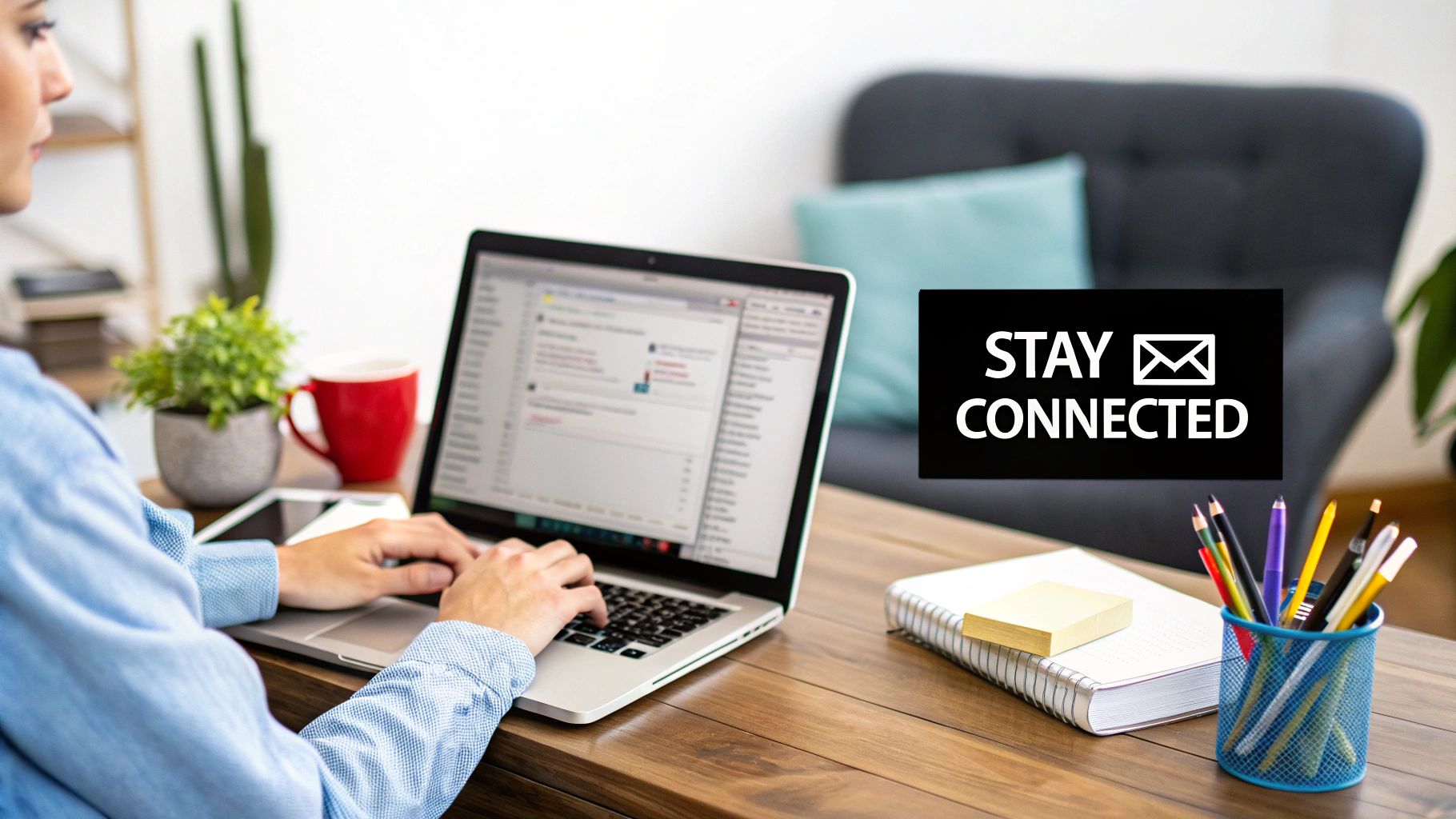 Even with a solid game plan, you're bound to have some lingering questions about networking. And that's completely normal. Let’s tackle some of the most common anxieties that pop up for introverts, one by one.
Even with a solid game plan, you're bound to have some lingering questions about networking. And that's completely normal. Let’s tackle some of the most common anxieties that pop up for introverts, one by one.
Thinking through these situations before they happen is a superpower. It gives you a ready-to-go script, so you can feel less flustered and more confident in the moment.
How Can I End a Conversation Without Seeming Rude?
This is a big one. The fear of getting stuck in a never-ending conversation can be so paralyzing that it stops you from even starting one. The secret is having a few polite exit lines in your back pocket.
You don't need some elaborate excuse. A simple, positive statement followed by a clear next step works wonders.
- Try this: "I've really enjoyed talking with you about [topic]. I'd love to connect on LinkedIn so we can stay in touch."
- Or this: "Well, I'm going to grab a coffee before the next session starts, but it was great meeting you."
The idea is to be warm and appreciative while clearly signaling you're moving on. Trust me, nobody will be offended.
What If I Go to an Event and Talk to No One?
First, let's reframe what success looks like. Just showing up is a win. Seriously. You stepped out of your comfort zone, got a feel for the environment, and observed what was going on. That's progress.
If you’re feeling the pressure, just lower the stakes. Give yourself a tiny, achievable goal, like asking one person a simple question—even if it's just about the coffee or the venue. You don’t have to walk away with a life-changing connection. You just practiced a skill and gathered some useful intel for next time.
This is all about progress, not perfection. Every single attempt, no matter how small it feels, builds your confidence. You aren't failing; you're just collecting data and getting better.
Is It Okay to Just Network Online?
Online networking is incredibly effective. For many roles and industries, you can absolutely build a powerful professional presence without ever leaving your home office. Knowing how to write engaging LinkedIn posts that drive real results, for example, can bring fantastic opportunities right to your digital doorstep.
That said, the strongest approach is usually a hybrid one. Lean into what you do best online, but be strategic about the in-person events you attend. Go for smaller, more focused gatherings that genuinely interest you. This way, you get the best of both worlds without completely draining your social battery.
How Do I Deal With the "Introvert Hangover"?
The post-event energy crash is very real. Pushing through it is a fast track to burnout. The best way to manage the drain is to plan for your recovery ahead of time.
Treat your downtime as a non-negotiable part of the networking process.
Block off time on your calendar immediately after an event to decompress. This might look like:
- Going for a quiet walk alone.
- Losing yourself in a good book for an hour.
- Doing absolutely nothing but enjoying the silence with a cup of tea.
When you build this recovery phase into your plan, networking becomes a sustainable practice you can maintain for the long haul—not just a dreaded chore.
Ready to let your expertise do the talking? With autoghostwriter, you can create compelling LinkedIn content that builds your network for you. Start attracting like-minded professionals today by visiting https://autoghostwriter.com.